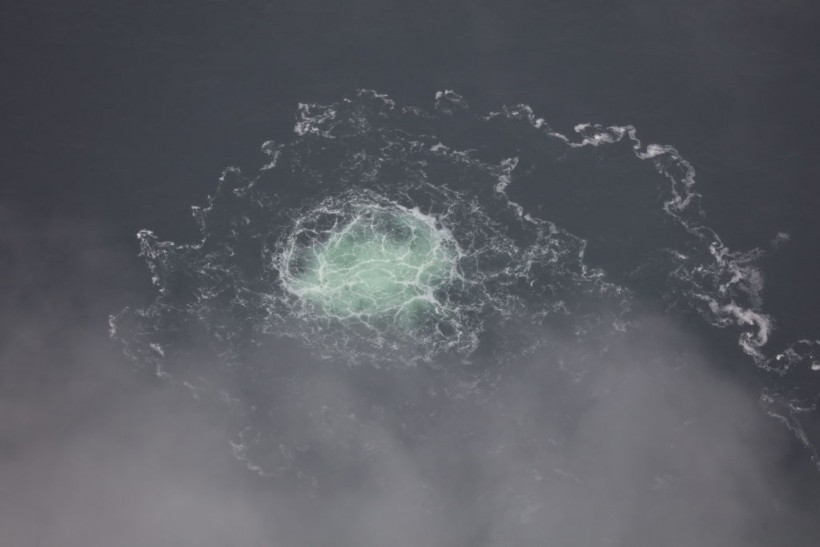A recent study published in The Seismic Record has unveiled new complexities in the seismic and infrasonic signals associated with the Nord Stream pipeline events of September 2022.
Initially, these events were linked to natural causes, but the intricate nature of the signals now suggests a possibility of sabotage.
The world was alerted to the rupture of pipelines in the western Baltic Sea, an incident that is still under active investigation by multiple countries.
Complex Seismic Signals
 (Photo : Swedish Coast Guard via Getty Images)
(Photo : Swedish Coast Guard via Getty Images)

Researchers have discovered that these seismic signals lasted longer than would be expected from a single explosive source.
This revelation has intensified suspicions of deliberate interference, as it aligns more with patterns observed in underwater volcanic or pipeline venting scenarios.
The study analyzed two of the largest Nord Stream events, which occurred on September 9 and 28, 2022. The first event coincided with a sudden drop in pressure within the Nord Stream 1 pipeline, while the second event affected both Nord Stream 1 and 2 pipelines.
The suspected act of sabotage reportedly used explosive charges to damage the pipelines, which are located at depths of about 80 meters below the sea surface.
The researchers used data from seismic and infrasonic stations in Sweden, Denmark, Germany, and Poland to characterize the signals generated by these events.
They found that the signals had a complex waveform, with multiple peaks and troughs, and a duration of about 10 seconds. They also noted that the signals had a low frequency content, ranging from 0.5 to 5 Hz, which is typical of underwater explosions.
However, the researchers also observed some features that were not consistent with a simple explosion model. For instance, they found that the signals had a strong azimuthal dependence, meaning that they varied depending on the direction of the observer.
They also detected some high-frequency components, up to 20 Hz, which are usually associated with seismic sources rather than explosions.
These findings suggest that the Nord Stream events involved more than one source, or a source that changed over time. The researchers proposed several possible scenarios to explain these complexities, such as multiple explosions, gas release, bubble oscillation, or pipeline rupture.
They also acknowledged that some of the signals could have been affected by propagation effects, such as reflections, refractions, or conversions of seismic waves.
Also Read: Understanding Nord Stream Methane Leaks: Environmental Impacts, Action Plans Identified
International Implications
The Nord Stream pipelines are significant conduits for natural gas between Russia and Europe. Any disruption or damage to these pipelines not only affects energy supply but also poses environmental risks due to potential leaks and spills.
The mysterious nature of these seismic events has prompted an international response, seeking to unravel whether they were acts of sabotage or unusual natural occurrences.
As investigations continue, nations connected by and reliant on the Nord Stream pipelines are on high alert. Security around these critical infrastructures has been heightened, and diplomatic channels are buzzing as countries seek clarity and assurance over the safety and integrity of their energy supply lines.
The Nord Stream sabotage mystery has also sparked political tensions and speculations, as some parties have accused or suspected others of being behind the attacks.
The motives and identities of the perpetrators, if any, remain unknown, but some analysts have suggested that they could be aiming to disrupt the energy balance in Europe, or to undermine the credibility and viability of the Nord Stream project.
The Nord Stream project, which consists of two parallel pipelines with a total capacity of 55 billion cubic meters per year, has been controversial since its inception.
It has faced opposition from some European countries, such as Ukraine, Poland, and the Baltic states, who fear that it would increase Russia's influence and leverage over Europe's energy security. It has also been criticized by environmental groups, who argue that it would contribute to climate change and endanger the marine ecosystem.
The Nord Stream project, however, has also received support from other European countries, such as Germany, France, and the Netherlands, who view it as a reliable and cost-effective source of natural gas. It has also been defended by Russia, who claims that it is a purely commercial and apolitical venture, and that it would enhance the energy diversity and stability in Europe.
The Nord Stream sabotage mystery, therefore, has added another layer of complexity and uncertainty to the already contentious and sensitive issue of energy cooperation and security in Europe.
It has also raised questions and concerns about the vulnerability and resilience of critical infrastructures, and the need for enhanced protection and prevention measures. The Nord Stream sabotage mystery, in short, has become a matter of global interest and importance.
Related Article: Why the Nord Stream Methane Leak Can Threaten the Environment
© 2024 NatureWorldNews.com All rights reserved. Do not reproduce without permission.

![Tsunami Hazard Zones: New US Map Shows Places at Risk of Flooding and Tsunamis Amid Rising Sea Levels [NOAA]](https://1471793142.rsc.cdn77.org/data/thumbs/full/70325/280/157/50/40/tsunami-hazard-zones-new-us-map-shows-places-at-risk-of-flooding-and-tsunamis-amid-rising-sea-levels-noaa.jpg)



